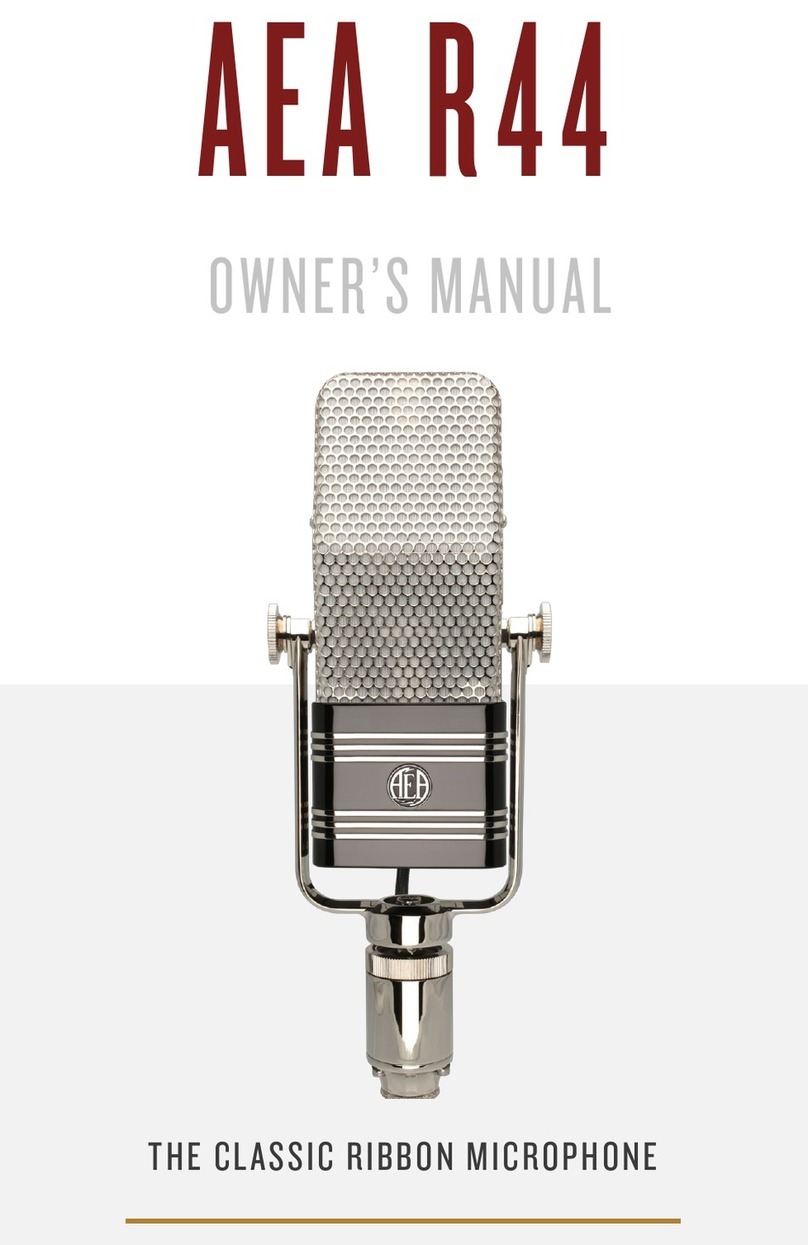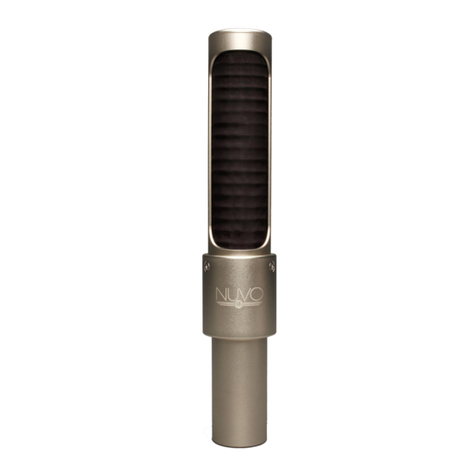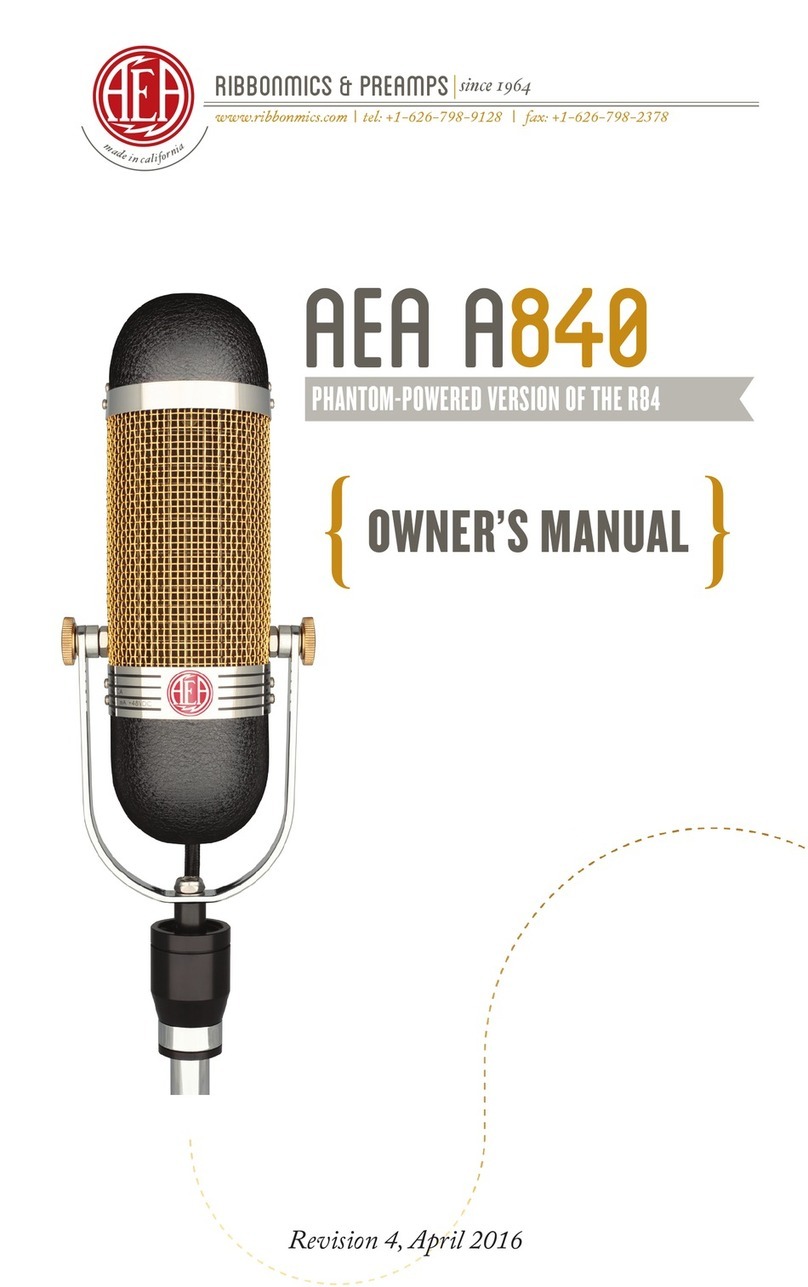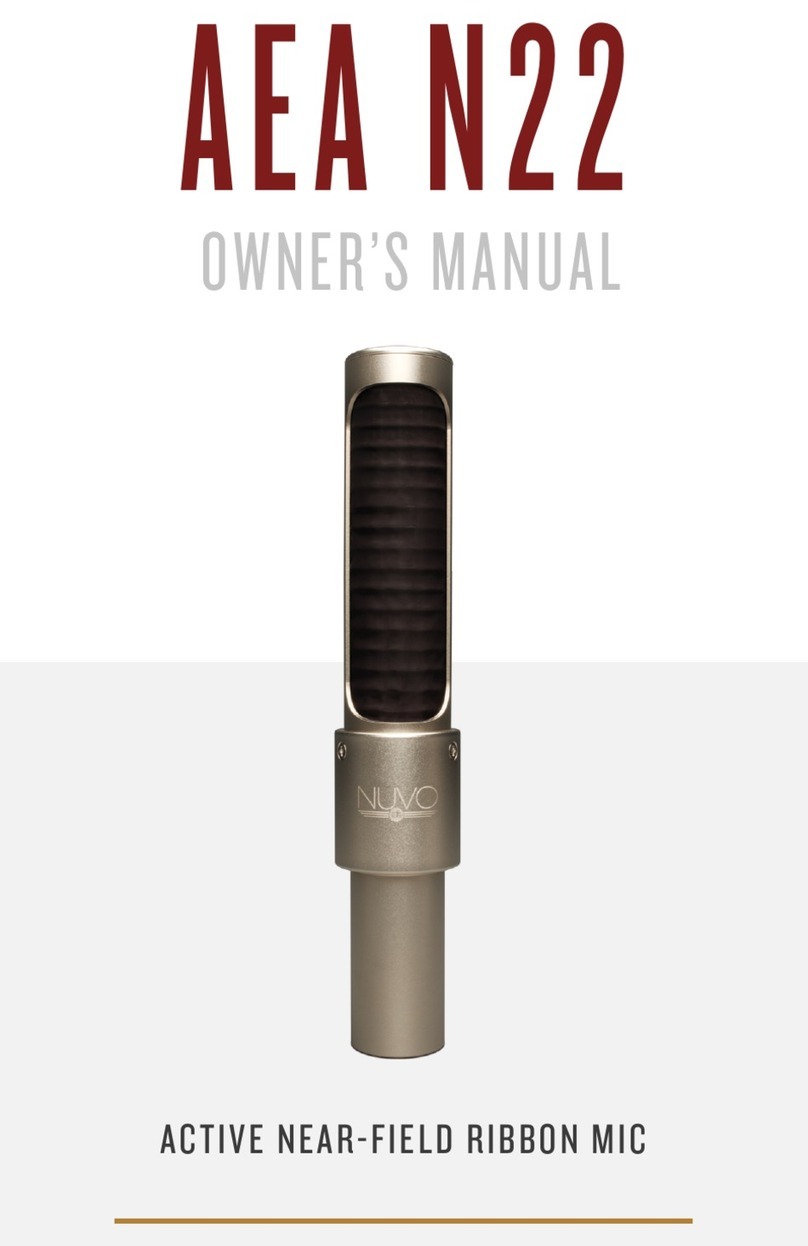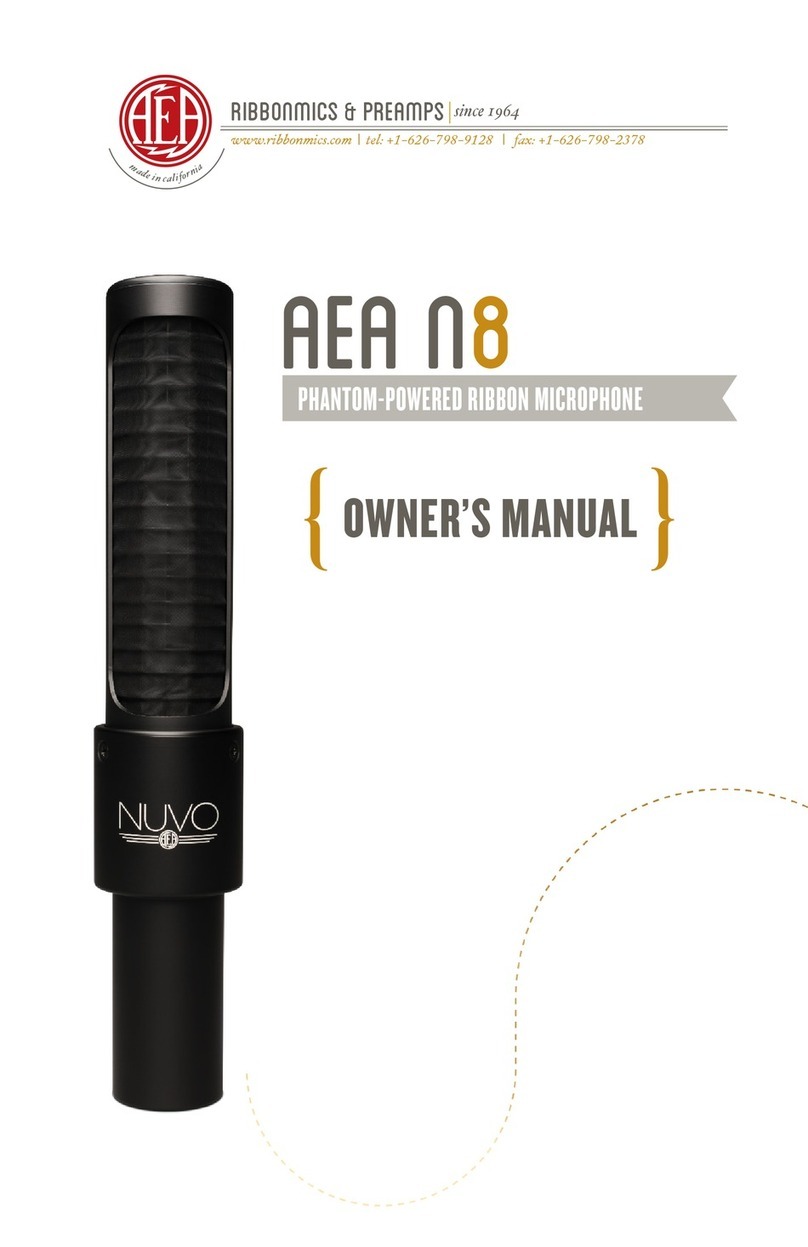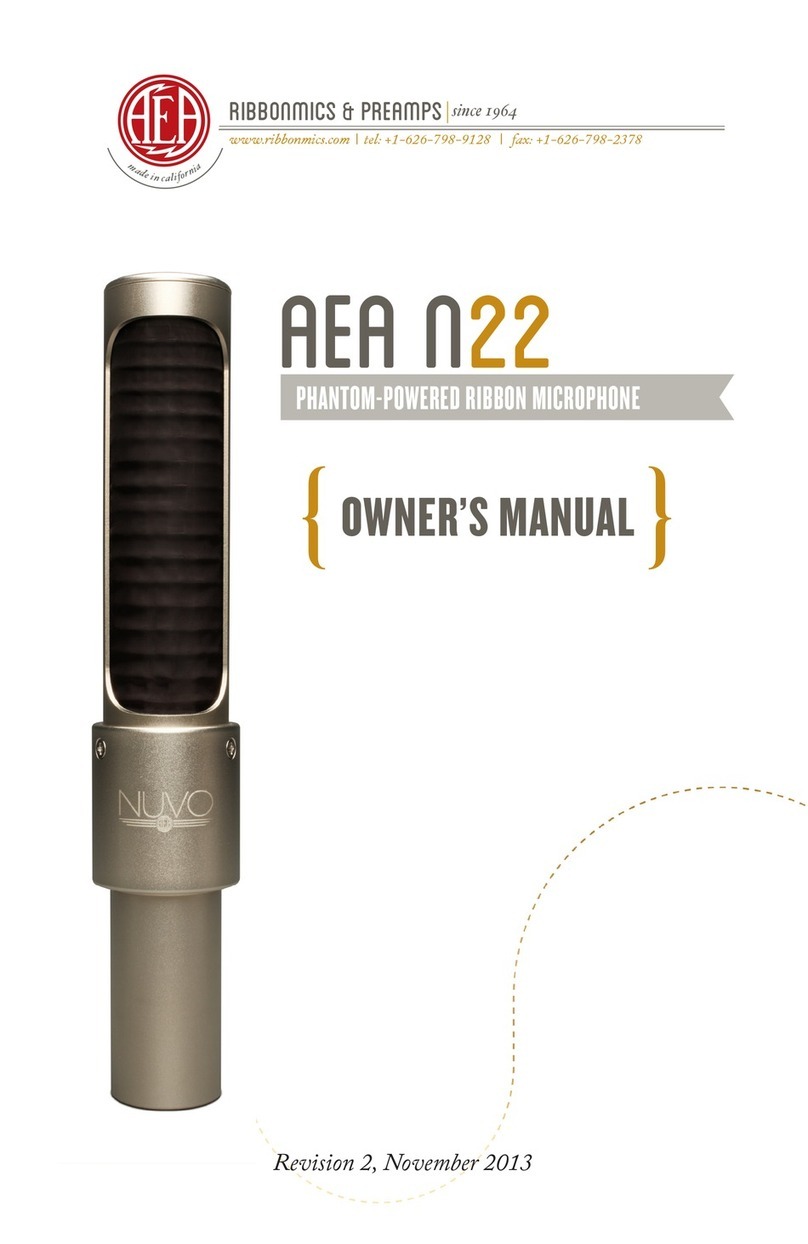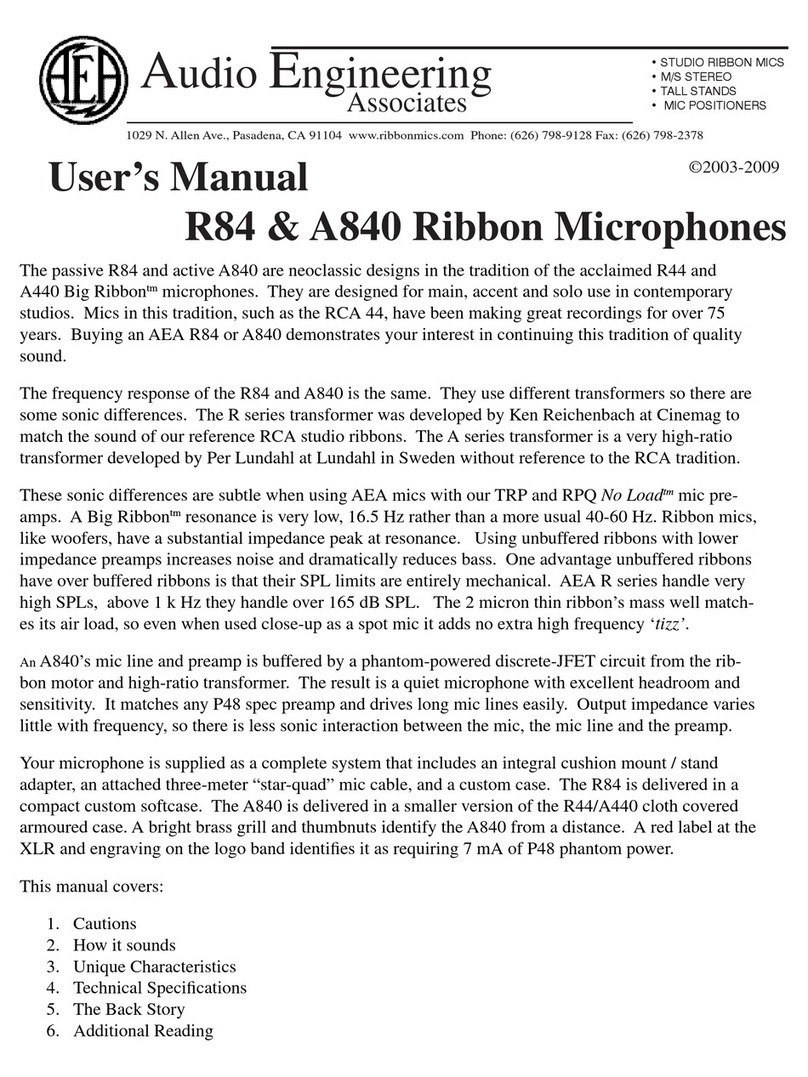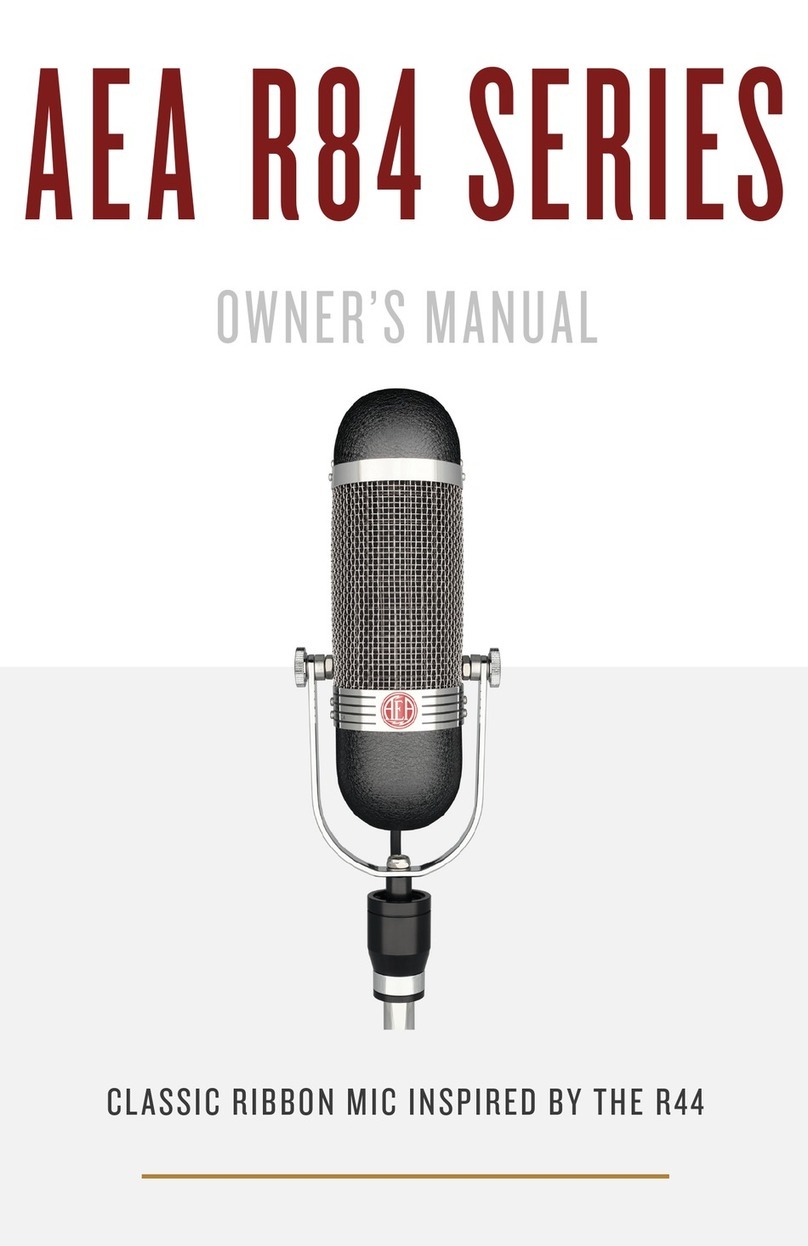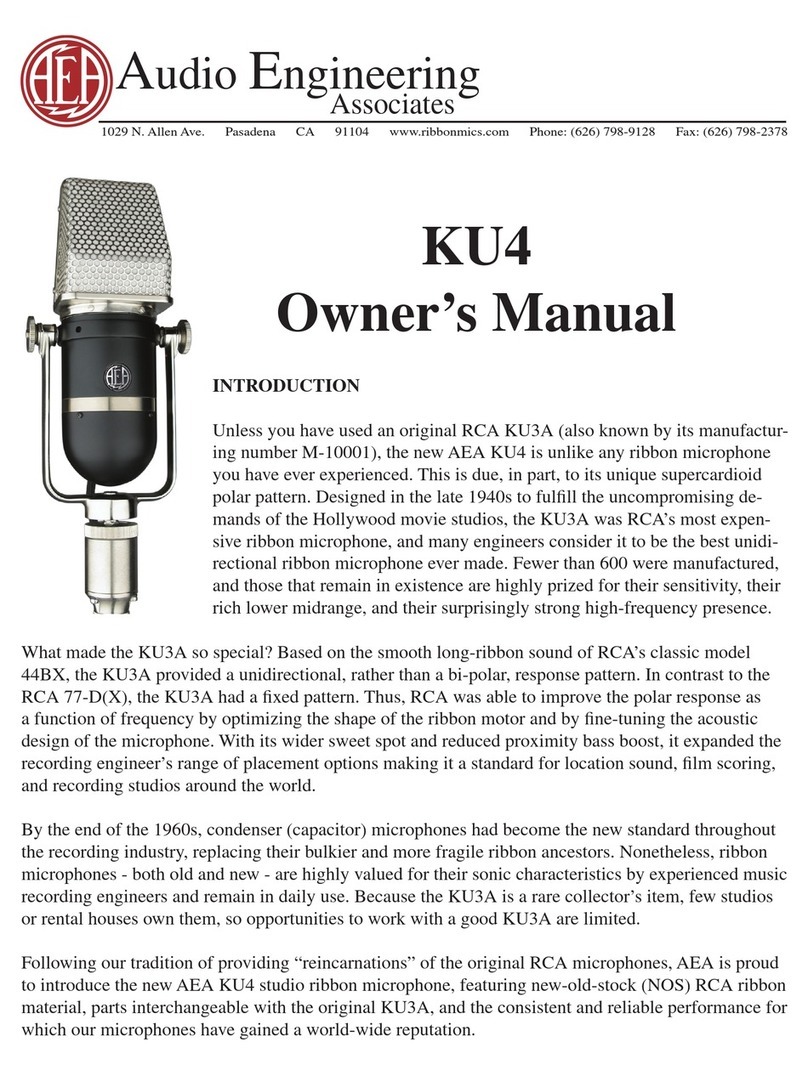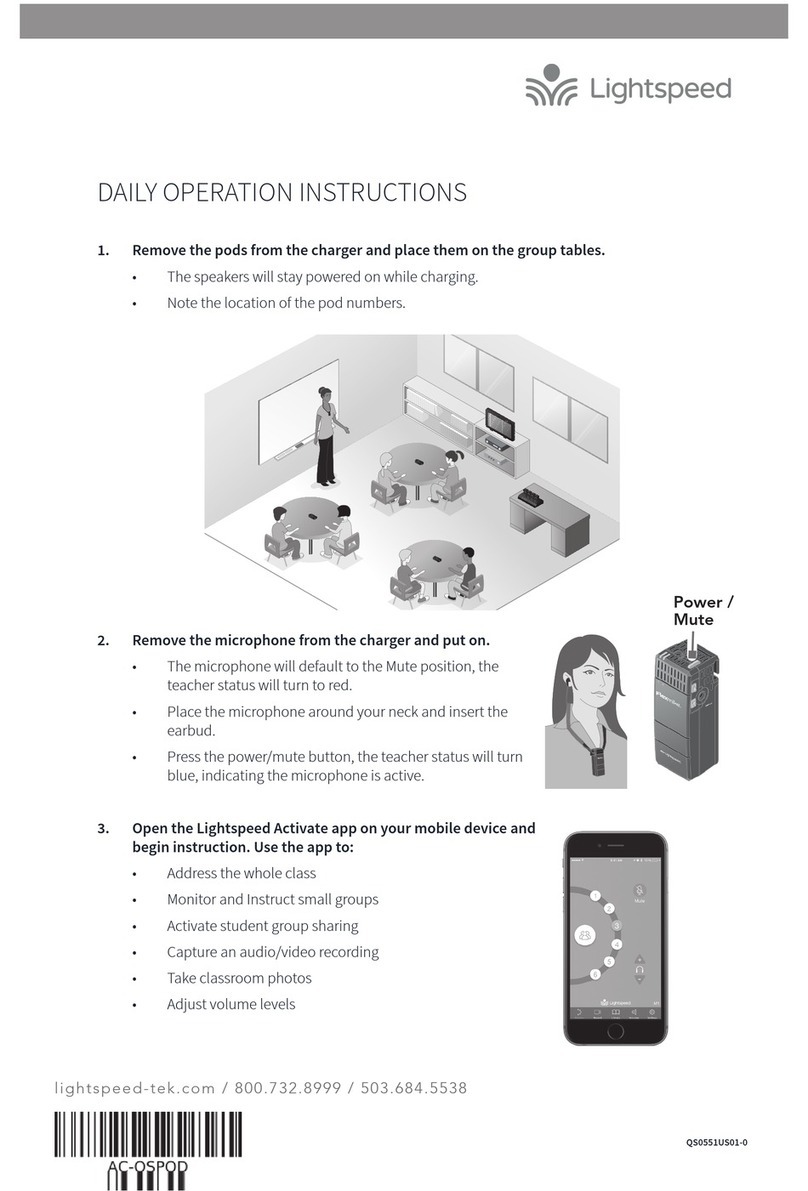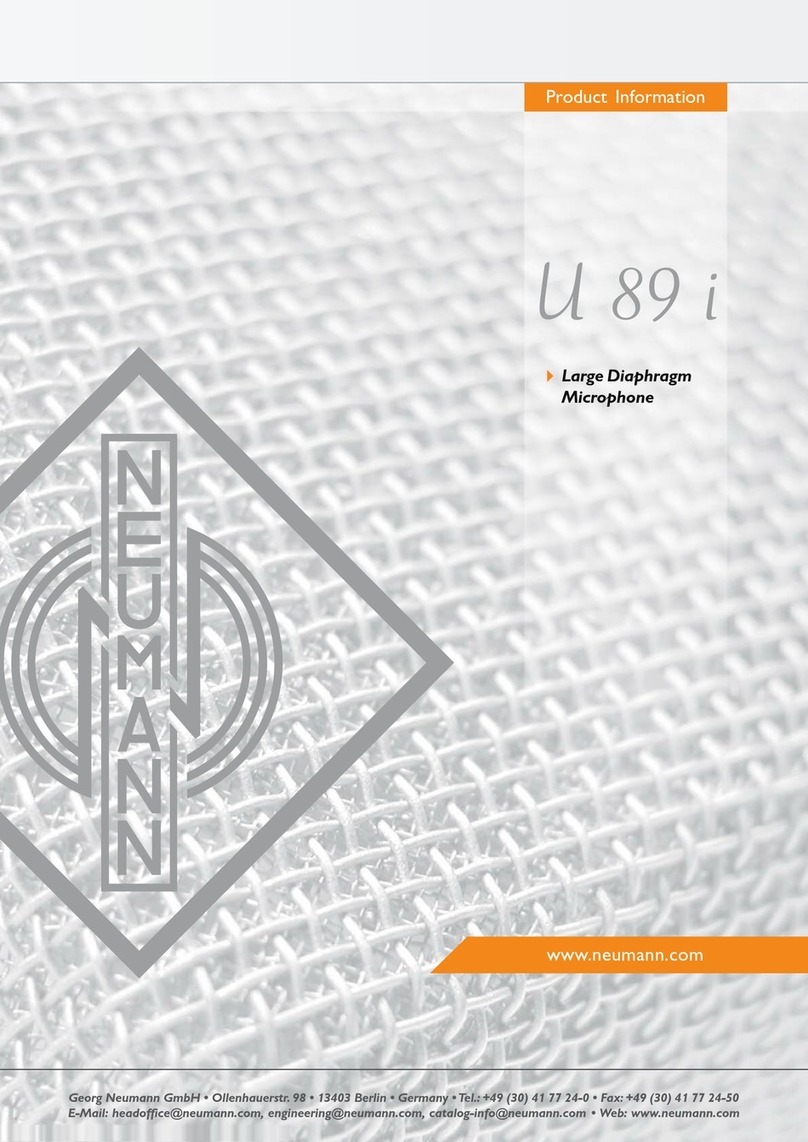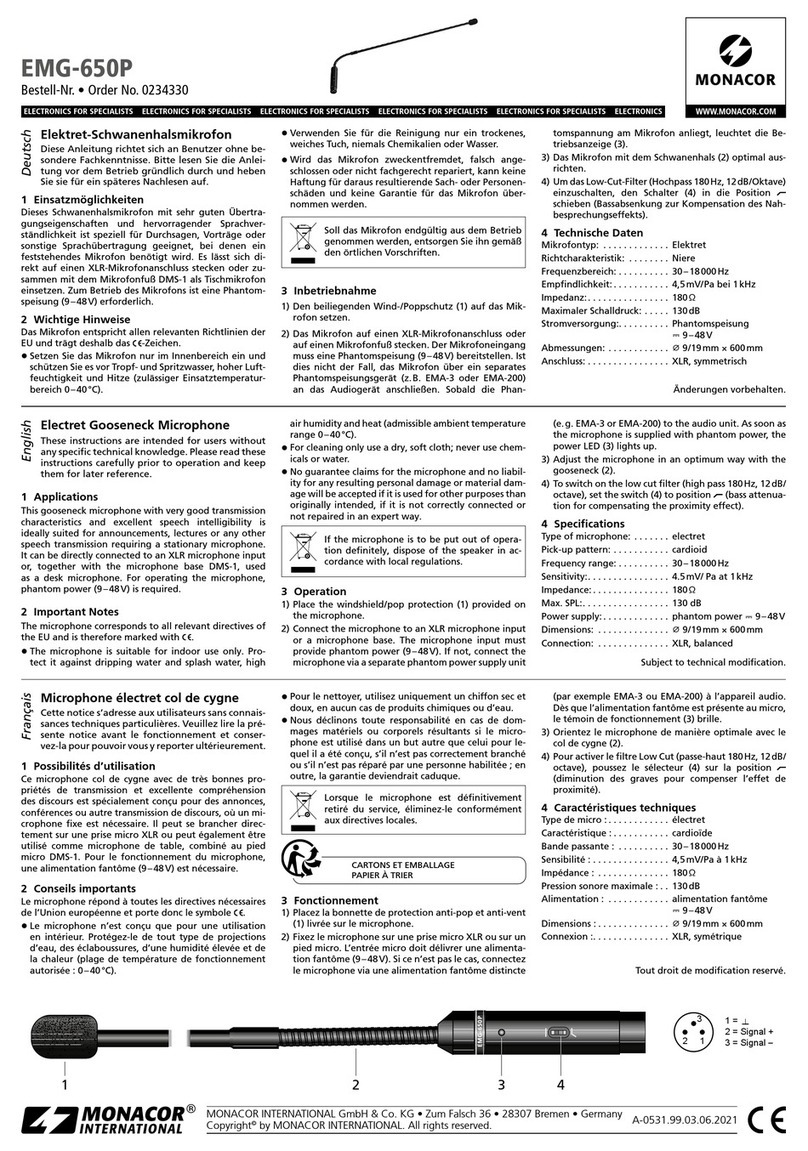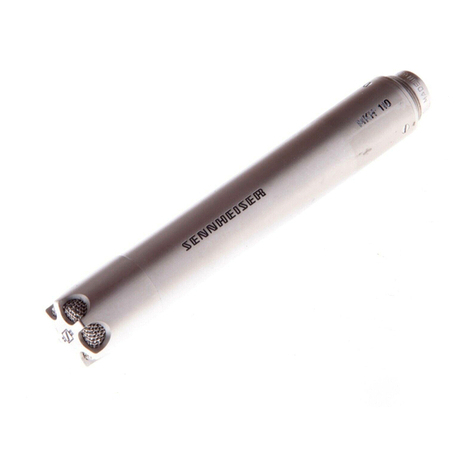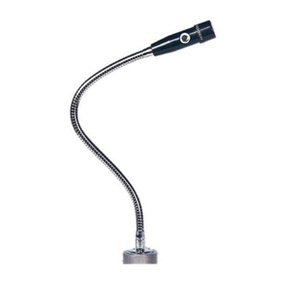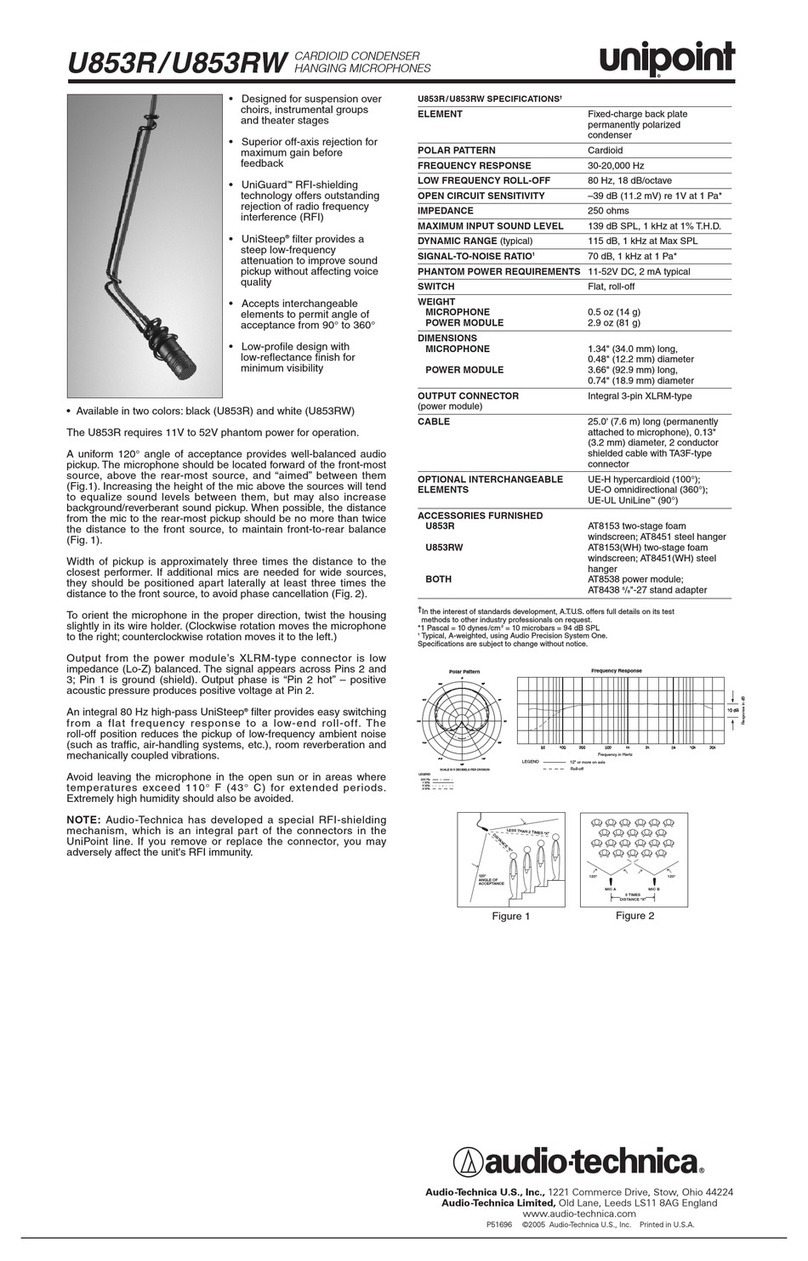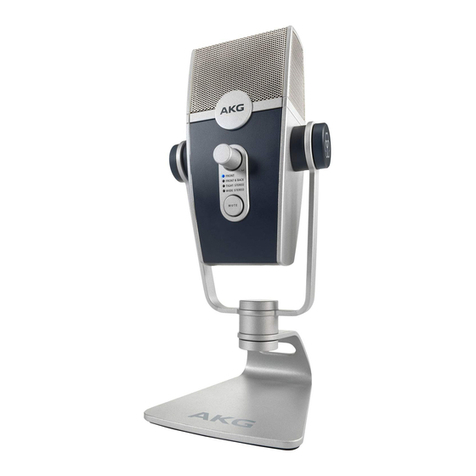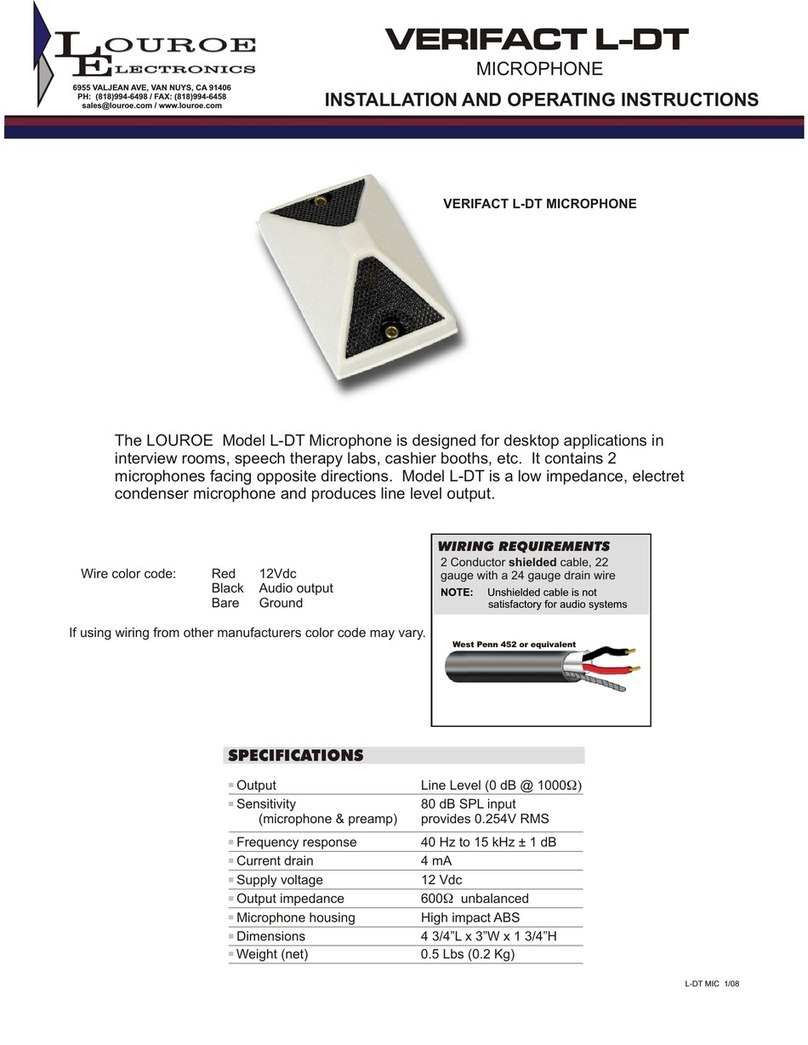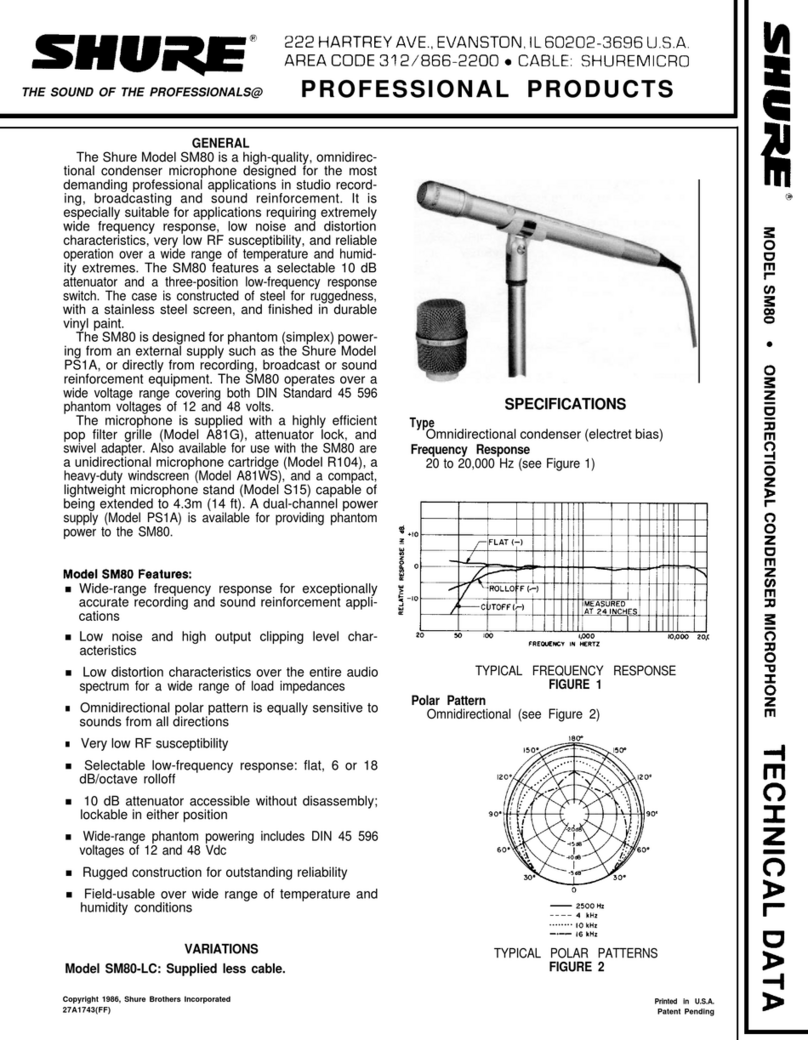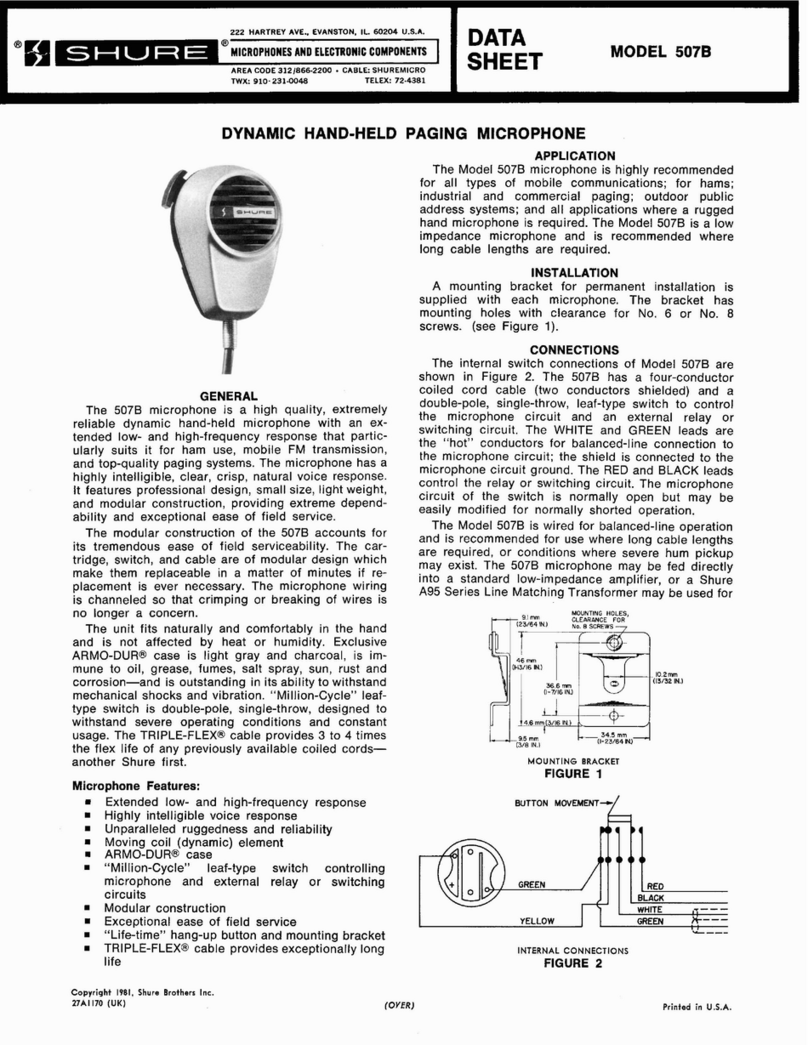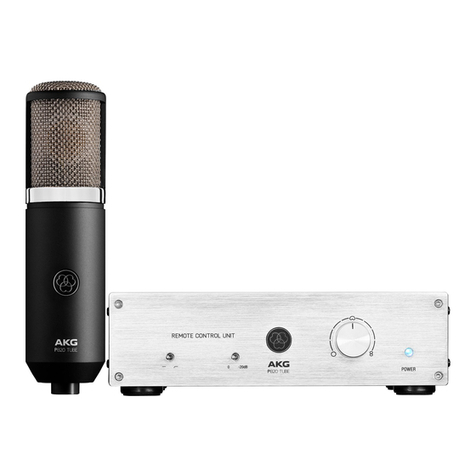AEA KU4 User manual

CLASSIC SUPERCARDIOID RIBBON MIC
AEA KU4
OWNER’S MANUAL

WELCOME
Congratulations on your purchase of the AEA KU4 ribbon
microphone and welcome to the AEA family! Unless you have used
an original RCA KU3A (also known by its manufacturing number
M-10001), the AEA KU4 is unlike any ribbon microphone you have
ever experienced. This is due, in part, to its unique supercardioid
polar pattern and character. With fewer than 600 KU3As
manufactured, those that remain in existence are highly prized for
their sensitivity, their rich lower midrange, and their surprisingly
strong high-frequency presence.
Following our tradition of providing “reincarnations” of the RCA
44 microphone, AEA is proud to introduce the AEA KU4 studio
ribbon microphone, featuring pure aluminum ribbon material, parts
interchangeable with the original RCA KU3A, and the consistent
and reliable performance for which our microphones have gained a
world-wide reputation.
Your KU4 microphone is 100% handcrafted in Pasadena, CA. AEA
is a family owned company with a small crew of skilled technicians
– most of them being musicians themselves. Proudly independent,
we still manufacture all our ribbon microphones and preamps by
hand from locally sourced parts.
We hope that the KU4 will help you capture many magical
performances that touch the heart. This manual will help ensure
that you get the best sound and longevity from your new
microphone. Please become part of the AEA community by sharing
your experiences with the KU4 via e-mail, phone or our social
media channels.
Wes Dooley
President of AEA
2

CONTENTS
WELCOME
INTRODUCTION
SUPPORT
GENERAL GUIDELINES
APPLICATION ADVICE
SPECIFICATIONS
2
4
4
5
8
10
3

INTRODUCTION
The KU4 is a side-address ribbon microphone with a supercardioid
pickup pattern. The reduced rear-lobe of the supercardioid pattern
means that, compared to a conventional bi-directional ribbon
microphone, the KU4 will have less pickup of ambient sound
from the rear. This makes it much easier to use in situations where
isolation between instruments is important or under less than ideal
acoustics. The angles of maximum off-axis sound rejection are
at ± 135°, and you can use those angles effectively to minimize
reflections caused by nearby surfaces. The KU4 has been designed
to reduce proximity bass boost to facilitate closer mic placement.
The lightly-tensioned, ultra low-mass ribbon produces response out
to 20 kHz (-7 dB) with fast, accurate transients, and without the
upper-midrange ringing common to condenser microphones.
These characteristics make the KU4 well suited for modern studio
music production, and ideal for low strings and brass instruments
as well as vocals.
WARRANTY
SUPPORT
Your KU4 comes with a one-year
limited warranty on parts and labor,
shipping not included. Registering
your product with AEA will extend
the warranty to a full three years.
Scan the QR code or visit our website
to register.
If you should encounter any problems with your KU4 microphone
or have questions regarding specific applications, please contact
quickest response.
To contact us by phone, please call +1-800-798-9127 from 9:00
a.m.- 5:00 p.m. PST Monday-Friday. AEA's repair center is located at
1029 N. Allen Ave, Pasadena, CA 91104, U.S.A.
4

GENERAL GUIDELINES
5
PHANTOM POWER
Your microphone is a valuable and important investment. Like most
recording equipment and musical instruments, it requires common
sense and basic care to keep it functioning properly. Given care,
your new microphone will perform dependably for decades.
Phantom power is not required or recommended for the passive
KU4. With a correctly wired cable and a properly working phantom
power supply, there is actually little danger of damaging a KU4
microphone with phantom power. However, passive ribbons such
as the KU4 can be damaged if ground (Pin 1) is accidently shorted,
miswired, or hot patched in a patch bay to (Pin 2) or (Pin 3). Using
phantom power with a faulty or miswired cable or a defective
supply can severely stretch or break a ribbon.
Since passive ribbon microphones and other transformer-coupled
microphones can be particularly vulnerable to phantom-power,
it is recommended to make disengaging phantom-power before
plugging and unplugging (the microphone) a habit.
MICROPHONE STORAGE
Keep the microphone covered when it is not in use. This will
reduce the damage that may result from a gust of air. Place the
supplied protective bag over the microphone when it is not in
use. For long-term storage, keep the microphone in its protective
case. An unprotected ribbon microphone can attract minute iron
particles, sometimes known as "tramp iron". If allowed, tramp iron
can penetrate the screen of a ribbon mic, sufficiently build up in
the magnetic gap and rub against the ribbon, causing distortion,
electrical shorts or tearing of the ribbon.

6
AIR TURBULENCE
Avoid exposing the microphone to strong air turbulence. Ribbon
microphones can withstand very high SPL (Sound Pressure Level),
but can be damaged by a strong gust of air or high levels of very
low frequency sound waves (from a kick drum or bass cabinet). This
can stretch the ribbon, reducing overall output, especially at high
frequencies.
Take precautions when recording any source that moves air. To
avoid damage, follow "The Hand Test": put the back of your hand
where the mic will be positioned; if you can feel the moving air,
place a pop-filter between the microphone and the source or
simply pull the mic farther back. When recording kick drums or
bass guitar cabinets, angle the microphone so that no air blasts the
microphone directly on-axis from the front or back.
Never blow directly into any microphone to test it. Not only
does this force moisture and dirt into the microphone, strong air
movement also can stretch the ribbon and while it may not break,
it nonetheless could significantly degrade the microphone’s
performance. Though the ribbon in your KU4 is protected by
a grille and acoustical fabric, which provides reasonable wind
protection while still allowing good high-end response, take care to
avoid high-wind outdoor environments.
STRAY MAGNETIC FIELDS
Ribbon microphones are fundamentally prone to picking up strong
external magnetic fields generated by light dimmers or nearby
power transformers. Though AEA designers paid much attention
to suppressing such sensitivity, it is still possible that you might
encounter this problem. If you should pick up a hum, try rotating or
moving the microphone to find a spot where the hum disappears,
and try eliminating potential sources of stray magnetic fields.
Rotate or move the mic to find the point of peak interference.
The high-performance magnets used in AEA microphones are
incredibly strong, and a significant amount of stray magnetic field
lines surround the microphone. To prevent data loss caused by
magnetic fields, avoid placing the microphone in close proximity
to hard drives, credit cards, analog tape, or any other magnetically
sensitive items.

7
MICROPHONE POSITIONING
Always use a sturdy microphone stand with the KU4. Weighing
in at around 5lbs, the KU4 requires mounting on a strong, robust
microphone stand with a heavy base or tripod. Large studio-booms
with an appropriate counter-weight are recommended to prevent your
KU4 from tipping-over and crashing, causing injury to itself, a musician,
or a valuable musical instrument.
The integrated cushion mount was designed to keep structure-borne
noise transmitted through the microphone stand and the cable away
from the low-tuned ribbon transducer. For the shock mount to function
as intended, it is important to vertically position the cushion mount
off of the mic stand and to rotate the microphone within the yoke, as
opposed to rotating the entire mic on the stand. This requires the use
of a swivel mount or posi-lock when using a boom arm for positioning
the microphone in a vertical conguration. Having the cushion mount
reaching out horizontally on a boom will cause inferior vibration
isolation and can also distort the cushion mount as time goes by.

8
PROXIMITY EFFECT
Proximity effect, a characteristic of all directional microphones,
is a rise in low-frequency response at closer working distances.
This can be used to superb effect, particularly with deeper vocals
to enhance richness and depth. A potential trade-off is reduced
articulation resulting from the masking effect on the treble due to
“excessive” bass boost.
(graph is a visualization, not a measurement)
APPLICATIONS ADVICE
We actively encourage users to visit AEAribbonmics.com to
access our comprehensive collection of in-depth articles and
tutorials featuring the KU4, along with a library of audio and
video demonstrations of the KU4 in action.

HOW TO MINIMIZE BLEED
9
A significant and ever-present challenge in contemporary studio
recording is minimizing “leakage” from nearby instruments into
the various microphones. The deep nulls of ribbon microphones
provide good rejection of unwanted sounds, which also can be
beneficial in sound reinforcement situations where “feedback”
is always a threat. While “gobos” can be effective in isolating
performers from each other, they introduce their own set of
problems - not the least of which are reflections in close proximity
to the performers and/or microphones that result in comb-filter
distortions. Because gobos usually are bulky and occupy valuable
floor space, they also inhibit the ability of the musicians to hear
and see each other easily. Such a setup requires complex and often
cumbersome headphone monitor mixes for the musicians.
SUPERCARDIOID DIRECTIONALITY
Because the KU4 has a supercardioid pattern, it has nulls at
approximately ± 135° from the principal (front) axis. Projected in
three dimensions, these nulls produce a “cone of rejection” to
the rear of the microphone that can be used effectively to reduce
leakage. Simply arrange the musicians so that nearby instruments
are placed in the “null” of their neighbor’s microphone, and vice
versa. Although this does not entirely eliminate the need for gobos,
it can significantly reduce their number.

10
SPECIFICATIONS
POLAR PATTERN
FREQUENCY RESPONSE
Operating Principle:
Directional Pattern:
Frequency Range:
Maximum SPL:
Sensitivity:
Output Impedance:
Load Impedance:
Phantom Power:
Polarity:
Off Axis Response
Relative Output:
Angle of Max Rejection:
Transducer Element
Material:
Thickness:
Width:
Length:
Microphone Dimensions
Height:
Width:
Depth:
Weight:
Ship Weight:
Connector:
Accessories Included:
Pressure gradient transducer
Supercardioid
<30 Hz to >20 kHz
140+ dB SPL above 200 Hz for 1% third harmonic
-52dBV (2.5 mV/Pa) (at 1 kHz into unloaded circuit)
300 Ω nominal
1.5 kΩ or greater
Not required or recommended
Pin 2 high for positive pressure on front of mic
-12 dB at 180°
135°
Pure aluminum corrugated ribbon
1.8 µm
0.082 in (2.1 mm)
1.25 in (28.6 mm)
12.6 in (32.00 cm)
4.6 in (11.68 cm)
3.7 in (9.40 cm)
4.7 lb (2.15 kg)
7.0 lb (3.20 kg)
XLR-3M wired to a 1.5m captive cable
Storage case, stand adapter, user manual

11
POLAR PATTERN
FREQUENCY RESPONSE
• Data below 200 Hz omitted due to measuring room restrictions
• 0 dVB is equivalent to 2.5 mV/Pa (-52 dBV)
• Normalized to 0 dB at 1kHz. 1/3 octave smoothing

Other manuals for KU4
1
Table of contents
Other AEA Microphone manuals



